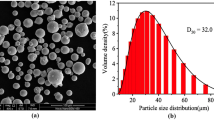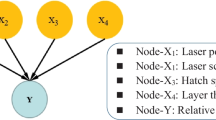Abstract
As a rapid developing additive manufacturing (AM) technology, selective laser melting (SLM) provides a promising way for intelligent manufacturing. The SLM part quality depends largely on the process parameters in the manufacturing process. Therefore, understanding the relationships between the input process parameters and the output part performances is critical to improve the part quality. In this work, the ensemble of metamodels (EM) is adopted and an adaptive hybrid leave-one-out error-based EM (EM-AHL) is developed to predict the powder utilization rate, the energy consumption, and the tensile strength of the as-built parts. First, the Taguchi experiment design is applied to obtain the sample points and the corresponding SLM experiments are conducted to get the experimental results. Second, the correlations between the process parameters (i.e., laser power, layer thickness, scanning speed) and the three responses are fitted using the proposed EM-AHL, which is constructed by aggregating three metamodels, Kriging, Radial basis fuction (RBF), and Support vector regression (SVR), according to the local measures. Finally, K-fold cross-validation and additional experiments validation methods are adopted to evaluate the prediction accuracy of the proposed EM-AHL. Results illustrate that the proposed EM-AHL not only outperforms the stand-alone metamodels but also provides more accurate results than the EM constructed by global measures (EM-G). Among the three prediction objectives, the prediction accuracy of the proposed EM-AHL has improved by up to 20% compared to the stand-alone metamodels. Besides, the main effects and contribution rates of process parameters on the responses are analyzed. Overall, the proposed EM-AHL method exhibits the excellent capability of guiding the actual SLM manufacturing.








Similar content being viewed by others
Abbreviations
- ALOO:
-
Average leave-one-out
- AM:
-
Additive manufacturing
- ANOVA:
-
Analysis of variance
- DOE:
-
Design of experiment
- EC:
-
Energy consumption
- EM:
-
Ensemble of metamodels
- EM-AHL:
-
Adaptive hybrid leave-one-out error-based EM
- EM-G:
-
EM constructed by global measures
- LOO:
-
Leave-one-out
- LP:
-
Laser power
- LT:
-
Layer thickness
- PUR:
-
Powder utilization rate
- RBF:
-
Radial basis function
- RMAE:
-
Relative maximum absolute error
- RMSE:
-
Root mean square error
- SLM:
-
Selective laser melting
- SS:
-
Scanning speed
- SVR:
-
Support vector regression
- TS:
-
Tensile strength
References
Aboulkhair, N. T., Everitt, N. M., Ashcroft, I., & Tuck, C. (2014). Reducing porosity in AlSi10Mg parts processed by selective laser melting. Additive Manufacturing, 1–4, 77–86. https://doi.org/10.1016/j.addma.2014.08.001.
Aminzadeh, M., & Kurfess, T. R. (2019). Online quality inspection using Bayesian classification in powder-bed additive manufacturing from high-resolution visual camera images. Journal of Intelligent Manufacturing, 30(6), 2505–2523. https://doi.org/10.1007/s10845-018-1412-0.
Aute, V., Saleh, K., Abdelaziz, O., Azarm, S., & Radermacher, R. (2013). Cross-validation based single response adaptive design of experiments for Kriging metamodeling of deterministic computer simulations. Structural and Multidisciplinary Optimization, 48(3), 581–605.
Chen, L., Qiu, H., Jiang, C., Cai, X., & Gao, L. (2017). Ensemble of surrogates with hybrid method using global and local measures for engineering design. Structural and Multidisciplinary Optimization, 57(4), 1711–1729. https://doi.org/10.1007/s00158-017-1841-y.
Cherry, J. A., Davies, H. M., Mehmood, S., Lavery, N. P., Brown, S. G. R., & Sienz, J. (2014). Investigation into the effect of process parameters on microstructural and physical properties of 316L stainless steel parts by selective laser melting. The International Journal of Advanced Manufacturing Technology, 76(5–8), 869–879. https://doi.org/10.1007/s00170-014-6297-2.
Delgado, J., Ciurana, J., & Rodríguez, C. A. (2011). Influence of process parameters on part quality and mechanical properties for DMLS and SLM with iron-based materials. The International Journal of Advanced Manufacturing Technology, 60(5–8), 601–610. https://doi.org/10.1007/s00170-011-3643-5.
Ferreira, W. G., & Serpa, A. L. (2015). Ensemble of metamodels: The augmented least squares approach. Structural and Multidisciplinary Optimization, 53(5), 1019–1046. https://doi.org/10.1007/s00158-015-1366-1.
Ford, S., & Despeisse, M. (2016). Additive manufacturing and sustainability: An exploratory study of the advantages and challenges. Journal of Cleaner Production, 137, 1573–1587. https://doi.org/10.1016/j.jclepro.2016.04.150.
Frazier, W. E. (2014). Metal additive manufacturing: A review. Journal of Materials Engineering and Performance, 23(6), 1917–1928.
Gu, D., Meiners, W., Wissenbach, K., & Poprawe, R. (2012). Laser additive manufacturing of metallic components: Materials, processes and mechanisms. International Materials Reviews, 57(3), 133–164.
Huang, R., Riddle, M., Graziano, D., Warren, J., Das, S., Nimbalkar, S., et al. (2016). Energy and emissions saving potential of additive manufacturing: The case of lightweight aircraft components. Journal of Cleaner Production, 135, 1559–1570. https://doi.org/10.1016/j.jclepro.2015.04.109.
Jin, R., Chen, W., & Sudjianto, A. (2002). On sequential sampling for global metamodeling in engineering design. In ASME 2002 International design engineering technical conferences and computers and information in engineering conference (Vol. 2, pp. 539–548). American Society of Mechanical Engineers Digital Collection.
Kappes, B., Moorthy, S., Drake, D., Geerlings, H., & Stebner, A. (2018). Machine learning to optimize additive manufacturing parameters for laser powder bed fusion of Inconel 718. 595-610, doi: 10.1007/978-3-319-89480-5_39.
Khodaygan, S., & Golmohammadi, A. H. (2017). Multi-criteria optimization of the part build orientation (PBO) through a combined meta-modeling/NSGAII/TOPSIS method for additive manufacturing processes. International Journal on Interactive Design and Manufacturing (IJIDeM), 12(3), 1071–1085. https://doi.org/10.1007/s12008-017-0443-7.
Kim, B., Lee, Y., & Choi, D.-H. (2009). Construction of the radial basis function based on a sequential sampling approach using cross-validation. Journal of Mechanical Science and Technology, 23(12), 3357–3365.
Lu, Z. L., Li, D. C., Lu, B. H., Zhang, A. F., Zhu, G. X., & Pi, G. (2010). The prediction of the building precision in the laser engineered net shaping process using advanced networks. Optics and Lasers in Engineering, 48(5), 519–525. https://doi.org/10.1016/j.optlaseng.2010.01.002.
Ma, F., Zhang, H., Hon, K. K. B., & Gong, Q. (2018). An optimization approach of selective laser sintering considering energy consumption and material cost. Journal of Cleaner Production, 199, 529–537. https://doi.org/10.1016/j.jclepro.2018.07.185.
Ning, F., Cong, W., Hu, Y., & Wang, H. (2016). Additive manufacturing of carbon fiber-reinforced plastic composites using fused deposition modeling: Effects of process parameters on tensile properties. Journal of Composite Materials, 51(4), 451–462. https://doi.org/10.1177/0021998316646169.
Paolini, A., Kollmannsberger, S., & Rank, E. (2019). Additive manufacturing in construction: A review on processes, applications, and digital planning methods. Additive Manufacturing, 30, 100894. https://doi.org/10.1016/j.addma.2019.100894.
Paul, R., & Anand, S. (2012). Process energy analysis and optimization in selective laser sintering. Journal of Manufacturing Systems, 31(4), 429–437. https://doi.org/10.1016/j.jmsy.2012.07.004.
Peng, T., & Chen, C. (2018). Influence of energy density on energy demand and porosity of 316L stainless steel fabricated by selective laser melting. International Journal of Precision Engineering and Manufacturing-Green Technology, 5(1), 55–62. https://doi.org/10.1007/s40684-018-0006-9.
Peng, S., Li, T., Zhao, J., Lv, S., Tan, G. Z., Dong, M., et al. (2019). Towards energy and material efficient laser cladding process: Modeling and optimization using a hybrid TS-GEP algorithm and the NSGA-II. Journal of Cleaner Production, 227, 58–69. https://doi.org/10.1016/j.jclepro.2019.04.187.
Peng, L., Taiping, Y., Sheng, L., Dongsheng, L., Qianwu, H., Weihao, X., et al. (2005). Direct laser fabrication of nickel alloy samples. International Journal of Machine Tools and Manufacture, 45(11), 1288–1294.
Qin, J., Liu, Y., Grosvenor, R., Lacan, F., & Jiang, Z. (2019). Deep learning-driven particle swarm optimisation for additive manufacturing energy optimisation. Journal of Cleaner Production, 245, 118702. https://doi.org/10.1016/j.jclepro.2019.118702.
Read, N., Wang, W., Essa, K., & Attallah, M. M. (2015). Selective laser melting of AlSi10Mg alloy: Process optimisation and mechanical properties development. Materials and Design, 1980–2015(65), 417–424. https://doi.org/10.1016/j.matdes.2014.09.044.
Shamsaei, N., Yadollahi, A., Bian, L., & Thompson, S. M. (2015). An overview of direct laser deposition for additive manufacturing; part II: Mechanical behavior, process parameter optimization and control. Additive Manufacturing, 8, 12–35. https://doi.org/10.1016/j.addma.2015.07.002.
Shi, J., Li, T., Zhang, H., Peng, S., Liu, Z., & Jiang, Q. (2015). Energy consummation and environmental emissions assessment of a refrigeration compressor based on life cycle assessment methodology. The International Journal of Life Cycle Assessment, 20(7), 947–956. https://doi.org/10.1007/s11367-015-0896-5.
Sun, D., Gu, D., Lin, K., Ma, J., Chen, W., Huang, J., et al. (2019). Selective laser melting of titanium parts: Influence of laser process parameters on macro- and microstructures and tensile property. Powder Technology, 342, 371–379. https://doi.org/10.1016/j.powtec.2018.09.090.
Taguchi, G. (1978). Performance analysis design. The International Journal of Production Research, 16(6), 521–530.
Tamrin, K., Nukman, Y., Sheikh, N., & Harizam, M. (2014). Determination of optimum parameters using grey relational analysis for multi-performance characteristics in CO2 laser joining of dissimilar materials. Optics and Lasers in Engineering, 57, 40–47.
Tapia, G., Elwany, A., & Sang, H. (2016). Prediction of porosity in metal-based additive manufacturing using spatial Gaussian process models. Additive Manufacturing, 12, 282–290.
Thijs, L., Verhaeghe, F., Craeghs, T., Van Humbeeck, J., & Kruth, J.-P. (2010). A study of the microstructural evolution during selective laser melting of Ti–6Al–4V. Acta Materialia, 58(9), 3303–3312.
Tian, W., Ma, J., & Alizadeh, M. (2019). Energy consumption optimization with geometric accuracy consideration for fused filament fabrication processes. The International Journal of Advanced Manufacturing Technology, 103(5–8), 3223–3233. https://doi.org/10.1007/s00170-019-03683-5.
Verma, A., & Rai, R. (2013). Energy efficient modeling and optimization of additive manufacturing processes. Paper presented at the 24th international SFF symposium—An additive manufacturing conference, SFF 2013.
Wang, Z., Palmer, T. A., & Beese, A. M. (2016). Effect of processing parameters on microstructure and tensile properties of austenitic stainless steel 304L made by directed energy deposition additive manufacturing. Acta Materialia, 110, 226–235. https://doi.org/10.1016/j.actamat.2016.03.019.
Whip, B., Sheridan, L., & Gockel, J. (2019). The effect of primary processing parameters on surface roughness in laser powder bed additive manufacturing. The International Journal of Advanced Manufacturing Technology, 103(9–12), 4411–4422. https://doi.org/10.1007/s00170-019-03716-z.
Zhou, Q., Rong, Y., Shao, X., Jiang, P., Gao, Z., & Cao, L. (2018). Optimization of laser brazing onto galvanized steel based on ensemble of metamodels. Journal of Intelligent Manufacturing, 29(7), 1417–1431. https://doi.org/10.1007/s10845-015-1187-5.
Zhou, Q., Shao, X., Jiang, P., Cao, L., Zhou, H., & Shu, L. (2015). Differing mapping using ensemble of metamodels for global variable-fidelity metamodeling. Computer Modeling in Engineering and Sciences, 106(5), 323–355.
Zhu, Y., Peng, T., Jia, G., Zhang, H., Xu, S., & Yang, H. (2019). Electrical energy consumption and mechanical properties of selective-laser-melting-produced 316L stainless steel samples using various processing parameters. Journal of Cleaner Production, 208, 77–85. https://doi.org/10.1016/j.jclepro.2018.10.109.
Acknowledgements
This research has been supported by the National Natural Science Foundation of China (NSFC) under Grant Nos. 51805179, 51775203, and 51721092, the National Defense Innovation Program under Grant No. 18-163-00-TS-004-033-01, the research fund under Grant No. 61400020401, the Research Funds of the Maritime Defense Technologies Innovation under Grant YT19201901.
Author information
Authors and Affiliations
Corresponding author
Additional information
Publisher's Note
Springer Nature remains neutral with regard to jurisdictional claims in published maps and institutional affiliations.
Electronic supplementary material
Below is the link to the electronic supplementary material.
Rights and permissions
About this article
Cite this article
Li, J., Cao, L., Hu, J. et al. A prediction approach of SLM based on the ensemble of metamodels considering material efficiency, energy consumption, and tensile strength. J Intell Manuf 33, 687–702 (2022). https://doi.org/10.1007/s10845-020-01665-z
Received:
Accepted:
Published:
Issue Date:
DOI: https://doi.org/10.1007/s10845-020-01665-z




